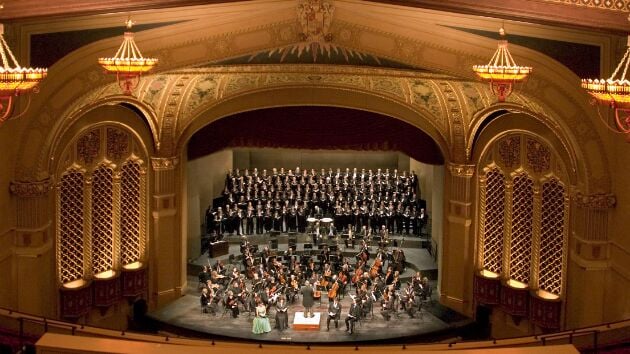
Gabriel Fauré’s Requiem is not like other Requiems. Usually they’re an opportunity for wailing and gnashing of teeth and trembling in fear of Death. Fauré will have none of that. On Friday, March 18, at San Jose’s California Theatre, Symphony Silicon Valley showed what Fauré has to offer. Conductor Paul Polivnick began the work began slowly and softly, in darkness and mystery, as if in awe of God. Then it gradually lightened up, becoming a gentle yet shining ode to the wonder of creation.
The SSV Chorale, supplemented by members of Resounding Achord, sang with intricate and subtle layering of the chorus parts, with a surge and flow reminding me that Vaughan Williams learned a lot from the French (he was in fact Fauré’s grandpupil). The chorus glided effortlessly through the Sanctus over light violins and harp, a gloriously luminescent moment. The equally light closing “In Paradisum” left the sopranos precariously perched on some high passages, yet overall Chorale director Elena Sharkova has trained her singers well.
Though the chorus sound could be retiring – a hazard of this venue’s deep-set stage – it came through the fullest version of Fauré’s carefully light orchestration at the climaxes.
Soprano soloist Rhoslyn Jones gave a dark, soulful rendition of the “Pie Jesu” movement with a full, strong voice and an individual approach to ornamentation. Baritone Jordan Shanahan, though less carrying in voice, was gratifyingly profundo in the depths of his solos.
As long as the chorus was to be on stage anyway, SSV programmed the rarely-heard choral version of Fauré’s brief Pavane. The chorus parts were awkwardly added to a previously existing work, and don’t quite fit in properly. The text by Robert Montesquiou is rather vapid, yet the chorus giving off all these French vowels became an appropriate sound for the setting.

The second half of the program went Russian. A rough and easy performance of Borodin’s In the Steppes of Central Asia – dominated by piercing high harmonics from the violins – was succeeded by the Ravel orchestration of Mussorgsky’s Pictures at an Exhibition.
The playing here was also lively with occasional rough spots. It was not, however, the focus of the show. The stage lights were dimmed – though not by enough – and a screen was lowered at the back of the stage. Around the conductor and percussionists, who blocked part of the view from the main floor, listeners watched a movie designed to be projected in synchronization with a performance of Pictures.
It consisted of a series of short films, mostly animated in varying styles, made by students and faculty at the University of Southern California, inspired by the subjects of the Victor Hartmann pictures that in turn had inspired Mussorgsky. At least one of the films, Ria Ama’s “Great Gate of Kiev,” utilized Hartmann’s original design.
The films were evocative and appropriate, and one, Andy Lyon’s “The Gnome,” was highly amusing for its visual matching with Mussorgsky’s abrupt music. Yet the video show was entirely distracting. The natural priority that human senses give to visuals, and the disparity between the familiarity of the music and the newness of the film, drew attention away from the orchestra’s performance.
The effect of the Pictures films was in turn squashed by an ill-advised visual encore. The orchestra played the music by Romain Paillot for a 2011 French cartoon titled Dum Spiro, depicting a Roman soldier trying to flee an angry bear who’s armed with air-to-ground guided missiles. If that doesn’t seem to make much sense, it didn’t on screen either, and the heavy-handedness of the cartoon and its purpose-written music seemed crass after the delicacy of most of the Pictures films, as well as dismissive of their achievement.
An opera company wouldn’t show Chuck Jones’ What’s Opera, Doc? as an encore to Wagner’s Ring. Masterworks though they both are, they belong far apart in different realms. On a lesser scale of drama, the same should have been true here.

